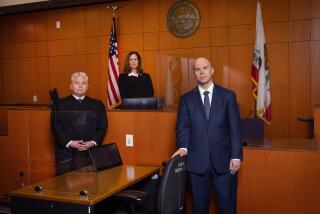Court Seeks Relief for Jammed Jurors
SANTA ANA — Prospective jurors summoned to Orange County Superior Court must often endure lines that stretch outside the courthouse and receive their assignment in an assembly room that is designed for 214 people but often holds double or triple that number.
Court administrators have expressed alarm about the overcrowding, saying it creates nightmarish logistic problems for them and poses a safety risk for jurors.
“It’s congested, it’s confusing, and I think it’s demeaning to the judicial system,” said Presiding Superior Court Judge Theodore E. Millard. “People should have a certain respect for the courts, and the courts should have facilities that are suitable to carry on the serious business that we do.”
Tonight, the courts will ask county supervisors for $1.5 million to build a second jury assembly room in an effort to relieve the overcrowding.
It remains unclear, however, whether the county can afford the project, especially as it is still struggling to recover from bankruptcy and to provide adequate funding for basic court operations.
Overcrowding has worsened in recent years as officials began to encounter increasing difficulty in finding jurors who are able and willing to serve on trials. About 550,000 prospective jurors were summoned last year, compared with 200,000 in 1992.
The courts reduced the term of jury service from four weeks to just one trial in an attempt to make jury service easier for prospective jurors. But the policy required more people to travel through the jury assembly room.
On Monday, Mary Watland of Huntington Beach waited with more than 400 prospective jurors in a line that snaked slowly through the courthouse’s central lobby and out the front door toward the Plaza of the Flags.
“I was astonished when I saw it,” said Watland, who waited in the line for 15 minutes before finally being ushered into the jury assembly room. At least Watland found a seat. Scores of juror candidates are often forced to sit on the floor or lean against walls until they are dispatched to their assigned courtrooms.
Administrators said Monday’s jury assembly ran smoothly compared to busier days, when more than 1,000 potential jurors line up around the courthouse. On the worst days, officials race to place prospective jurors in any available space, from the cafeteria to any empty courtrooms and offices.
Inside the assembly room, the packed conditions sometimes overwhelm the air-conditioning system, heightening the discomfort level.
“We get worried. It’s so tight in there. The airflow isn’t designed for the number of people we have,” said Pat Hill, the court’s assistant executive officer for judicial support. “We have to be careful that no one hyperventilates.”
A few months ago, one prospective juror collapsed in the back of the assembly room. Paramedics arrived promptly but could not make it through the hundreds of people to reach the victim, so they finally had to evacuate the entire room.
“I’ve been in a panic ever since,” said Alan Slater, the Superior Court executive officer. “We really try to make people comfortable. But in this climate, it’s difficult.”
Perhaps the worst day in recent memory was the Tuesday after Labor Day, when 1,500 to 2,000 jurors arrived for duty, about 1,200 of those for potential service on one death penalty case alone. They waited in lines stretching outside the courthouse, while parking lots and streets nearby were jammed.
Beyond safety concerns, Slater expressed fear that the long lines and lack of adequate seating would discourage prospective jurors from serving on panels. The courts regularly receive complaints from jurors about the assembly process.
“We have to summon quite a number of people just to get the [number we need],” Hill said.
But several jurors waiting in line Monday said the inconveniences would not affect their willingness to serve.
“I think they are doing the best they can under the circumstances,” Watland said. “People are helpful and move you through quickly. . . . But I think they should have a seat for everyone.”
The $1.5-million expansion project would create a second jury room in a portion of the courthouse’s third-floor cafeteria area, doubling the overall assembly space. The courts are asking that the money come from the county’s general fund, which is far from flush.
At least one supervisor, however, said she would probably not vote for the proposal.
“I’ve looked through the budget and I don’t see anything in the general fund that can accommodate” the request, Supervisor Marian Bergeson said.
More to Read
Sign up for Essential California
The most important California stories and recommendations in your inbox every morning.
You may occasionally receive promotional content from the Los Angeles Times.










